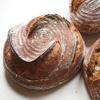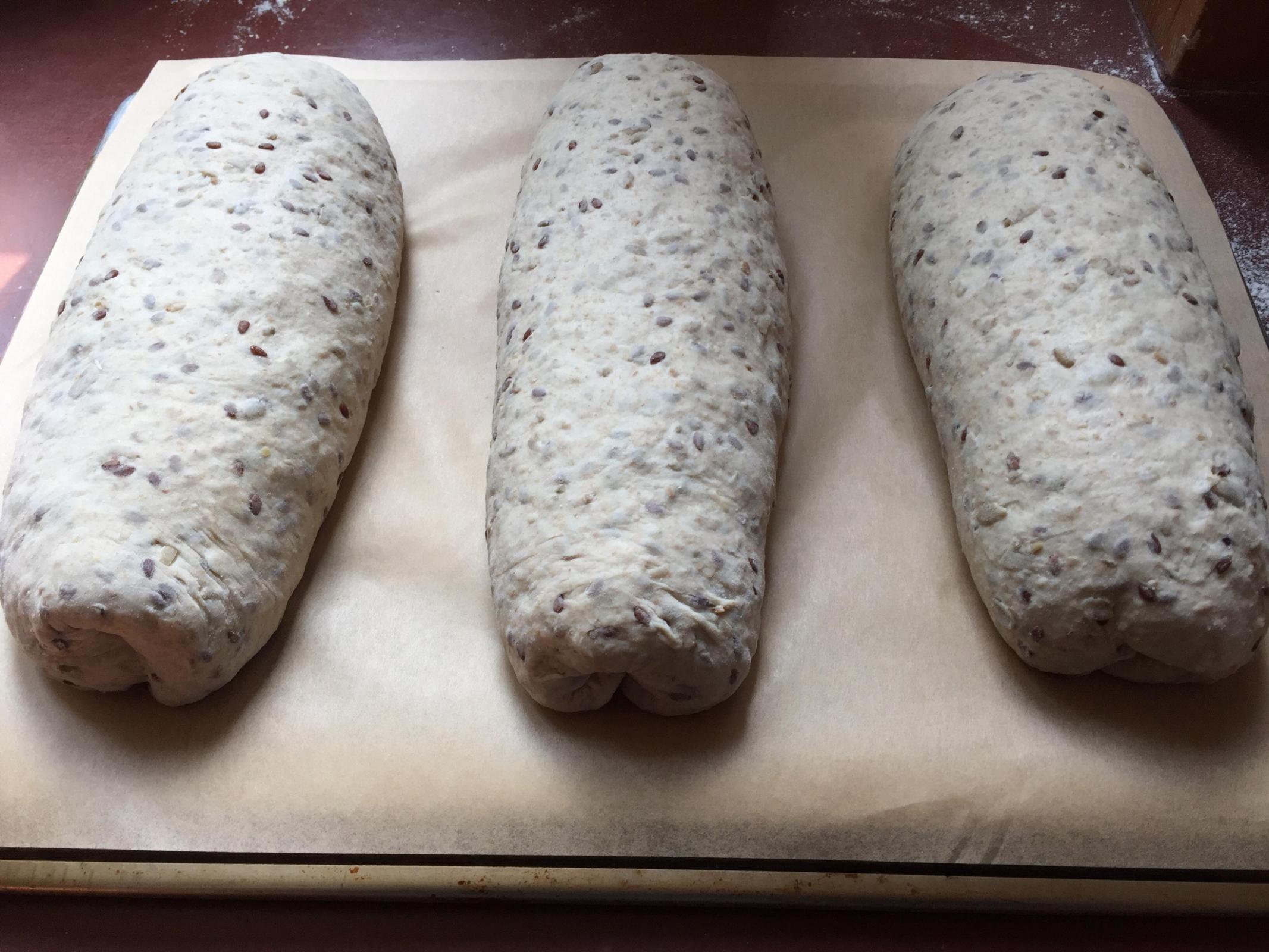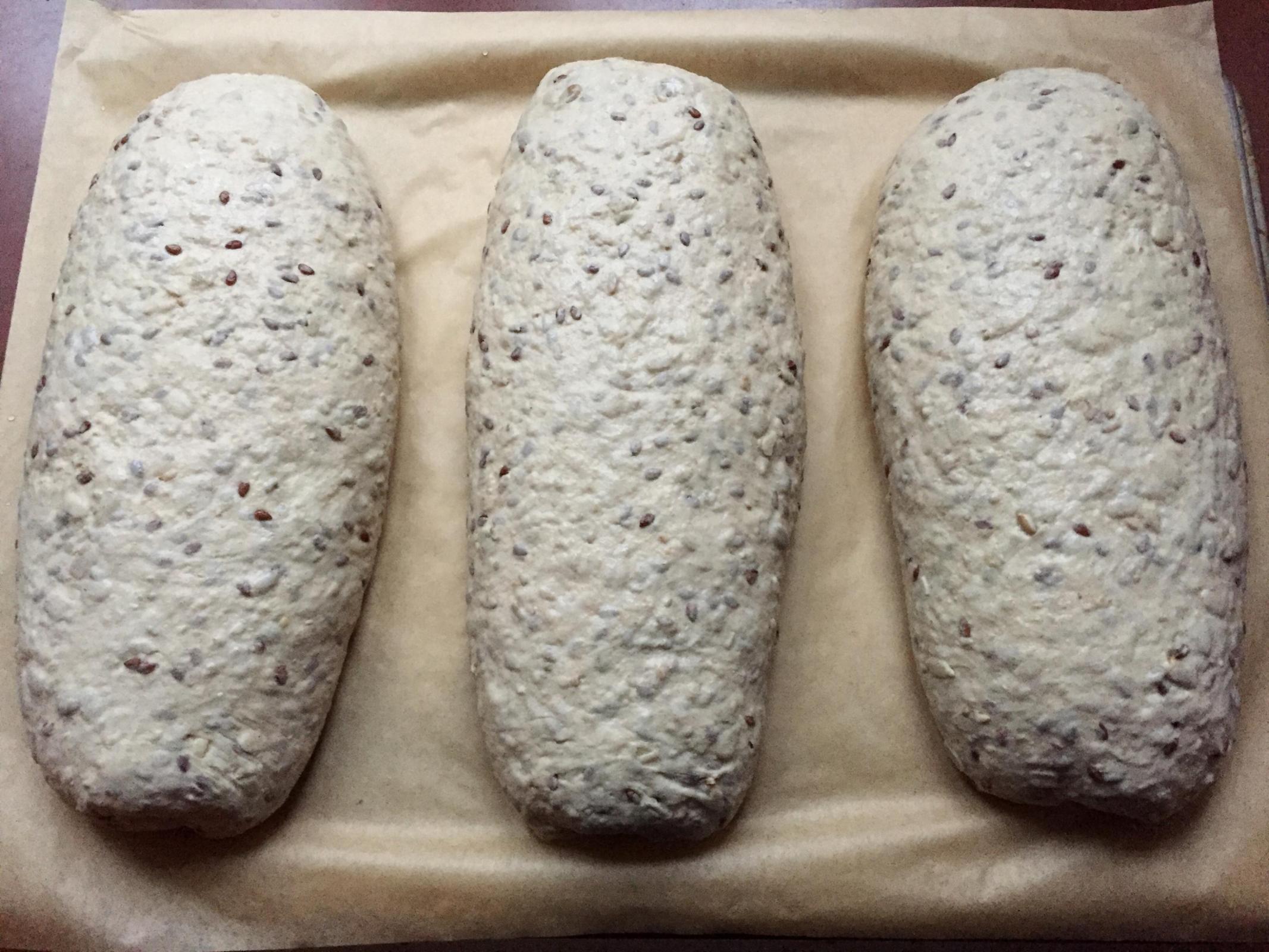
Community Bake: Hamelman's 5-Grain Levain

This morning I baked my version of Hamelman's 5-grain Levain. I think this is one of the best breads in Hamelman's book - it is tasty, it is easy to make, and it never fails. Needless to say, I make hardly any changes to the original recipe. Some of the details of my version are:
- Rye berries are coarsely milled into what would probably be called rye chops rather than cracked rye and the fine flour is not sifted out;
- I use rolled oats (Hamelman doesn't specify);
- Instead of water for the final dough I use the whey that I get from straining my own version of a "yogurt cheese;"
- A Kitchen Aid is used for mixing. The dough is scaled to make 3 loaves at 850-900 grams each, which pushes the limit in the KA (and probably doesn't help its longevity);
- Loaves are shaped into "logs" which keeps the slices nicely even sized for sandwiches;
- Dough is retarded in refrigerator at roughly 38˚F overnight and there is no IDY.
Some photos showing the progress of the bake follow.
Cracked Rye before soaking Levain after about 12 hours
Soaker after about 12 hours Dough after mixing

Divided and preshaped Final shaping into logs


On parchment and into a bag for retarding After 18 hours refrigerated retard
Three shallow diagonal scores During the steaming

The final product
Thanks @DanAyo for setting this up!
-Brad


Comments
You are welcome. But, the Community Bakes could be considered a somewhat selfish endeavor. I learn as much as others.
The Community Bake seems to benefit all who participate and also those that read the post. And for that I am grateful!
I’m guessing that your loaves are cooling. We await the crumb shot.
Brad, I am surprised how dry and strong your doughs appear. Did you use the required amount of water? My doughs are wet and don’t appear near as strong. I suspect I may be over mixing. I plan to address that next bake.
Great Job! And your documentation coupled with the images are outstanding.
Dan
my dough was way to stiff BUT then I realized I forgot to add the water in the final mix.So after the dough was divided , I added in water in two different ways. One in the Kitchenaid and the other with a spraybottle and scoring the dough > but now it is a waiting game.
I have been making this bread for many years now, it is one of our favorites. I used the percentages as listed in the book (I have the first edition and I haven’t compared it to your post, but I will later today). A couple of things stand out to me. The flaxseed turns gelatinous and the rolled oats tend to disintegrate when mixing. Both affect the texture of the dough. I don’t find it very dry and it is quite extensible and somewhat sticky. I suspect the whey contributes to the stickiness as well, and although I used the same amount of whey as water in the formula, it may make the dough a bit drier, but I’m not sure.
I will post a crumb shot later as well, though I do not go for an open crumb with this bread. Based on all the other posts, it’s probably time that I go for the hand mixing next time.
-Brad
Edited: Danny, the formula you posted is essentially the same as in my edition. Perhaps the flour you are using is less thirsty than the one I use.
Brad, what I should have written is your dough looks relatively dried compared to most of the other bakers. I would like to have my dough look like yours. My doughs are wet, sticky, and extremely extensible.
Dan
and I love the documentation. I was wondering about the dough texture as quite different from my usual breads. Kat
Kat,
Thanks for your comments. The dough is quite strong and a lot drier than most other sourdough loaves that I make, which are typically 78-82% hydration lately. The soaker has a big effect on the texture of the dough as I just wrote to Danny above.
-Brad
Awaiting the crumb photo with positive expectations.
David
David,
I will post crumb shots soon. As I mentioned, I’m not going for open crumb with this bread so it usually is closer to the tight crumb of a Greenstein-style Jewish rye.
This is one of the few breads that I retard free-form rather than in baskets. The moisture that is released during fermentation ends up on the surface of the dough and gives that beautiful sheen to the finished loaf.
-Brad
you have nailed it! it is a great challenge with some great bakes so far
Leslie
Thank you Leslie.
What would be the baking equivalent of Carnegie Hall? I’m not sure, but it still takes a long time to get there. I just checked my old notebooks (yes, I have a serious note taking habit) and I first baked this bread in 2011 based on this version with bulgur. There are many bakes between that one and this one, not all pretty. The beauty of baking is that they all taste good even if they don’t look like the image in your mind’s eye. Good luck and don’t give up.
-Brad
I'm sure it tastes as good as it looks.
Happy baking!
David
David,
As someone familiar with this bread you know how good it is. I’ve been looking at my past notes and a few years ago I substituted cracked freekeh for the rye. This imparted a smokey flavor (freekeh is green durum that is smoke dried) giving ir additional depth. Time to revisit that option.
-Brad
and love the way the seeds come through...with the beautiful contrast of the shiny crust... Kat
Kat,
It seems like an inordinate amount of seeds the first time you make it, but they don’t overwhelm the bread at all. Thanks for your kind words.
-Brad